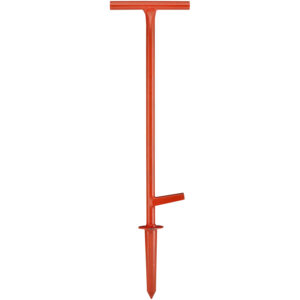Description
Dibbles are custom made probes that create a planting hole specific to one container type and size. A variety of hollow tips that match specific container sizes including Ray Leach Cone-tainer™ cells and several cavity sizes of Styrofoam® block containers are available. Using hollow tips reduces the compaction created by solid tips and extracts a core of soil that can be used to cover the top of the root plug. Most designs have one or two metal foot pedals for forcing the point into the soil. Scalping blades can be attached to some dibbles.
Application
Dibbles or dibble sticks are used to plant small container stock in light textured upland soils or alluvial bottomland soils in wetland restoration projects. They are easy to handle and are particularly useful for sandy or loamy soils and confined spaces. They should not be used in heavy soils as they tend to compact soil around the planting hole and can contribute to frost heaving. After making the hole, the planter simply inserts the container plant, covers it with a layer of native soil, and moves to the next hole.
References / Additional Information
Haase, D.L.; Landis, T.D.; Dumroese, R.K. 2014. Outplanting [Chapter 17]. In: Wilkinson, K.M.; Landis, T.D.; Haase, D.L.; Daley, B.F.; Dumroese, R. K., eds. Tropical nursery manual: A guide to starting and operating a nursery for native and traditional plants. Agriculture Handbook 732. Washington, DC: U.S. Department of Agriculture, Forest Service: 313-337.
Klein, A. 2020. How to plant seedlings with a dibble bar (video). Kansas Forest Service Facebook Page.
Shaw, N.L.; Halford A; McAdoo, J.K. 2015. Establishing big sagebrush and other shrubs from planting stock. Great Basin Factsheet Series No. 8. Sage Grouse Initiative. 6 p.


